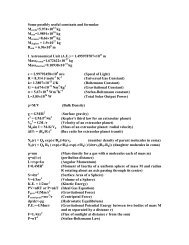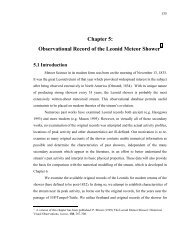Edwards W.N., Brown P.G., Weryk R.J., ReVelle D.O.
Edwards W.N., Brown P.G., Weryk R.J., ReVelle D.O.
Edwards W.N., Brown P.G., Weryk R.J., ReVelle D.O.
You also want an ePaper? Increase the reach of your titles
YUMPU automatically turns print PDFs into web optimized ePapers that Google loves.
Infrasonic Observations of Meteoroids 227<br />
Fig. 3 Comparison of infrasonic<br />
mass to panchromatic mass.<br />
Infrasonic mass determined by<br />
fitting theoretical signal<br />
amplitude and period to observed<br />
signal. Panchromatic mass<br />
determined through standard<br />
light curve analysis (Ceplecha<br />
et al. 1998)<br />
MI ¼ 1:00<br />
0:54<br />
0:60MP 0:12<br />
where MI is the infrasonic mass and MP is the photometric mass in kilograms (Fig. 3).<br />
5 Discussion and Conclusions<br />
Recent observations of regional meteor infrasound using the newly installed ELFO infrasound<br />
array in tandem with the SOMN all-sky cameras and CMOR have discovered that the<br />
flux of meteor generated infrasound from small meteoroids\10 cm in diameter is far higher<br />
than previously observed. Although final calibration of the flux is in progress (awaiting<br />
corrections for observing biases and sky coverage), the flux appears to be at least 1 event/<br />
month for meteor panchromatic magnitudes –2 and brighter. Interestingly, <strong>ReVelle</strong> (1974)<br />
predicted *20 events in a winter season might be detectable. The current results are a lower<br />
limit as no daytime events or meteors occurring during bad weather are detected. This<br />
suggests that <strong>ReVelle</strong>’s (1974) estimate may be quite close to the actual effective detection<br />
limit. Work continues on correlating radar observed meteor head-echoes with the infrasound,<br />
preliminary results suggesting a handful of positive correlations/detections.<br />
Recent observations using the European Fireball Network (Oberst et al. 1998) and the<br />
IMS station I26DE (<strong>Brown</strong> et al. 2007) showed that high altitude infrasound from shower<br />
meteors was possible. This more complete and general survey suggests that not only is<br />
infrasound production possible at these altitudes, it appears that it is quite common for<br />
meteors \–4 magnitude with at least 8 of 18 signals originating at altitudes [80 km.<br />
Similar to the results of <strong>Brown</strong> et al. (2007), ballistic shocks make up the majority of<br />
observations with non-ballistic observations being far more rare and often associated with<br />
meteors undergoing gross fragmentation.<br />
Using the current observations of ballistic and quasi-ballistic meteor generated infrasound<br />
we are at last able to begin testing and constraining the theoretical predictions<br />
developed by <strong>ReVelle</strong> (1974) more than 30 years ago. We find that most of our<br />
ð1Þ<br />
123





